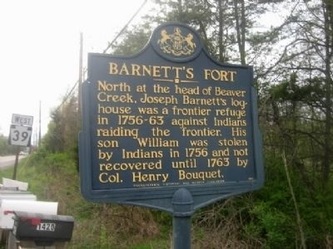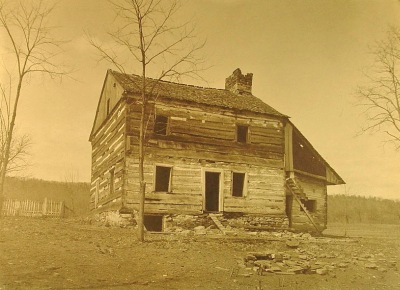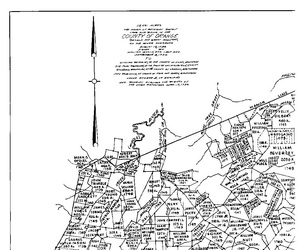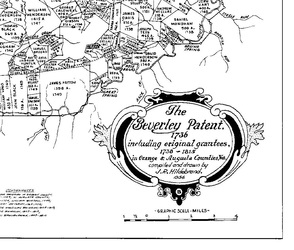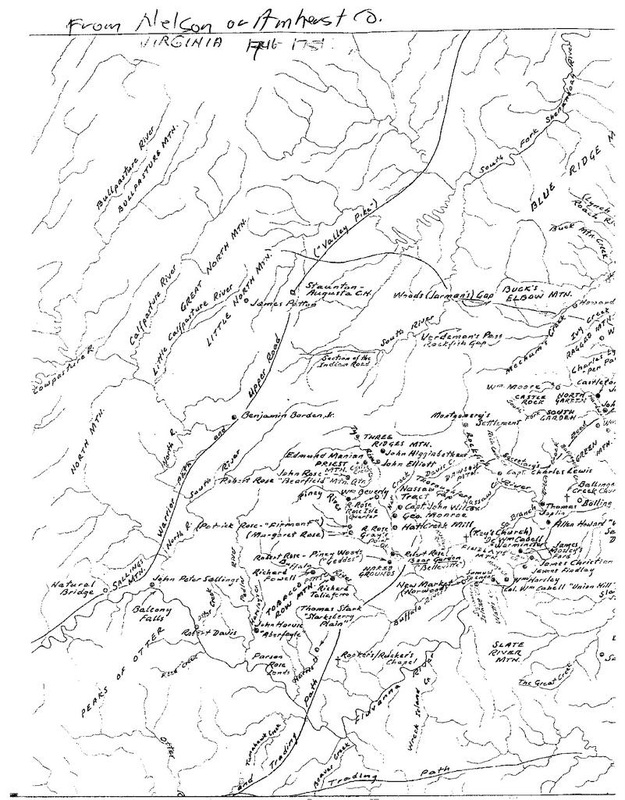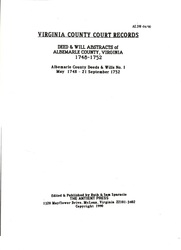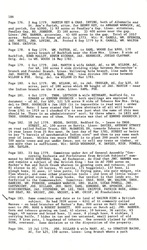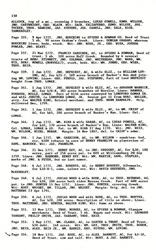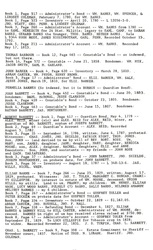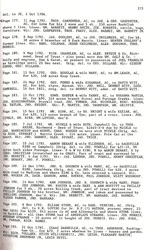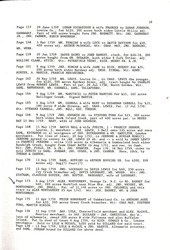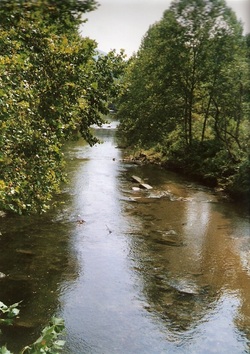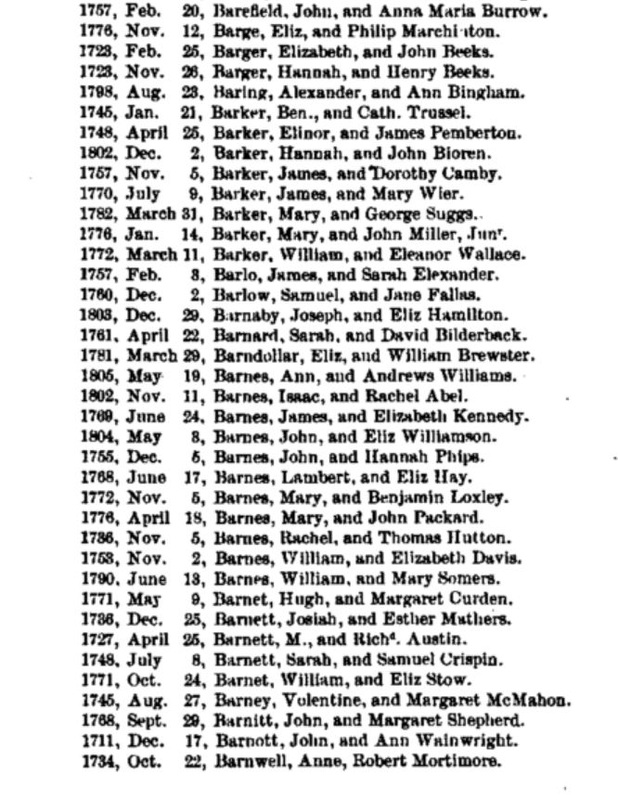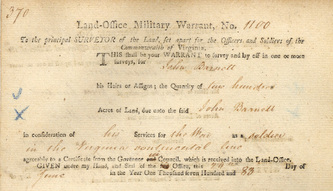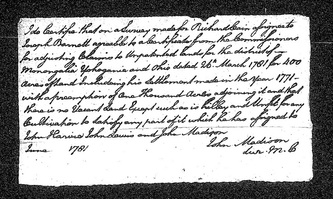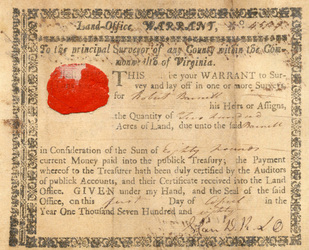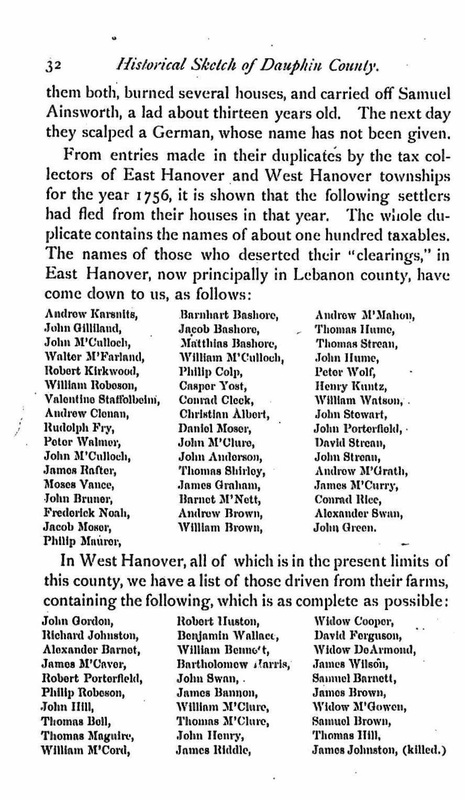_Barnett's Fort in West Hanover Township, c1900
Cabin was located 3 miles NE of Linglestown, PA_ In the album housing this photo, former HSDC Librarian William A. Kelker pasted an article from the Reformed Church Record written by Daniel Miller of Reading, PA and published July 10, 1902, a short time after the photo was taken. The article, entertaining if not entirely accurate, states that in the mid-1700s Mr. Barnett and several other families erected this block house in West Hanover Township to protect them from Indians while they worked their farms. One day Mr. Barnett and Mr. Mackey were out in the fields when they heard that their families had been murdered by Indians. Shortly after mounting their horses and heading for home, they were ambushed. Mr. Barnett suffered a broken arm and dropped his rifle. Though Barnett escaped and later recovered, an Indian picked up his rifle and killed Mr. Mackey.
Mr. Barnett learned that his family had not been murdered and was entirely safe except for his son William of eight or nine years who, along with a son of the deceased Mr. Mackey, had been captured by the Indians and taken westward. After some time, Colonel Croghan and 500 men (Mr. Barnett among them) marched west to Fort Pitt in the hope of signing a treaty with the Indians. There Col. Croghan learned the Barnett boy had been adopted by an Indian family who had lost their own son.
The peace treaty was eventually signed, but Col. Croghan was unable to secure Mr. Barnett's son before the contingent returned east. Further efforts proved fruitful and the boy was eventually returned to Fort Pitt and then to Carlisle. According to Miller's story, after being separated for three years, "by a singular coincidence his father went there on business and reached the place after dark of the same day that the boy arrived. He put up at the same hotel where his boy was already sleeping", and after only a moment of doubt by the son, William and his father reunited and returned home to their family. As for the Mackey boy, he was sent to England, returned to America as a British solider during the Revolutionary War, and while on furlough reunited with his mother and left the British army.
Some remains of the house should still be visible off of Piketown Road. According to the Pennsylvania Historical and Museum Commission marker, Joseph Barnett's log house at the head of Beaver Creek served as a frontier refuge during the French and Indian War. William was stolen in 1756, and it was not until 1763 that he was brought back by Col. Henry Bouquet. Photo ID: ALB7-01328.
The cabin was located 3 miles NE of Linglestown, PA
Mr. Barnett learned that his family had not been murdered and was entirely safe except for his son William of eight or nine years who, along with a son of the deceased Mr. Mackey, had been captured by the Indians and taken westward. After some time, Colonel Croghan and 500 men (Mr. Barnett among them) marched west to Fort Pitt in the hope of signing a treaty with the Indians. There Col. Croghan learned the Barnett boy had been adopted by an Indian family who had lost their own son.
The peace treaty was eventually signed, but Col. Croghan was unable to secure Mr. Barnett's son before the contingent returned east. Further efforts proved fruitful and the boy was eventually returned to Fort Pitt and then to Carlisle. According to Miller's story, after being separated for three years, "by a singular coincidence his father went there on business and reached the place after dark of the same day that the boy arrived. He put up at the same hotel where his boy was already sleeping", and after only a moment of doubt by the son, William and his father reunited and returned home to their family. As for the Mackey boy, he was sent to England, returned to America as a British solider during the Revolutionary War, and while on furlough reunited with his mother and left the British army.
Some remains of the house should still be visible off of Piketown Road. According to the Pennsylvania Historical and Museum Commission marker, Joseph Barnett's log house at the head of Beaver Creek served as a frontier refuge during the French and Indian War. William was stolen in 1756, and it was not until 1763 that he was brought back by Col. Henry Bouquet. Photo ID: ALB7-01328.
The cabin was located 3 miles NE of Linglestown, PA
Photo of Staunton Virginia Courtesy of Betty Haslett
The Beverley Patent Map
with names of settlers
Amherst or Nelson County Virginia 1751
courtesy of Lewis Barnett
Albemarle County, Virginia Deeds & Records 1748-1752
courtesy of Carol Kenney Lovitt
PA Revolutionary War Index
& VA Tax Payers 1782-1787
Washington County, Virginia Court Records
"B" Surname Marriages Dauphin County
Virginia Land Patents
Inhabitants of New Garden, Chester County, Pennsylvania
SOURCE: History of Chester County, Pennsylvania With Genealogical and Biographical Sketches by J. Smith Futhey and Gilbert Cope, Philadelphia: Louis H. Everts & Co. 1881, pages 580-84.
NEW GARDEN.
This township was named from New Garden, in the county Carlow, Ireland. It was included in the survey made in 1700 by Henry Hollingsworth, of 30,000 acres, of which 15,500 were patented to Letitia Penn, as has been shown. The remainder, or 14,500 acres, was patented to William Penn, Jr., May 24, 1706, by the commissioners of property, Edward Shippen, Griffith Owen, and Thomas Story, and, like his sister’s tract, received the name of the manor of Stenning. The bounds of the manor may be thus described:
Beginning at a hickory tree on the west side of a branch of White Clay Creek, thence east nine hundred and twenty-five perches to a corner of Letitia’s manor (Kennett), thence by the same south two thousand three hundred and fourteen perches to another corner, thence West South West nine hundred and thirty perches to White Clay Creek, West fifty-eight perches, and North by land of the London Company two thousand six hundred and seventy-four perches, to the place of beginning.
Thus the township of New Garden, as it was before losing a corner to London Britain, embraced just that part of the manor which lay north of the circular line, being, according to an early estimate, 8913 acres. Before obtaining the patent William Penn, Jr., had already appointed Griffith Owen, James Logan, and Robert Ashton as his attorneys, he being about to return to England. The land was not immediately taken by settlers, but after a few years several families of Friends arrived from Ireland, and, settling there, gave the name of New Garden to their new home, in remembrance of that place in Ireland. The first sale of land was, perhaps, in 1708, to Mary Rowland. In 1712, Gayen Miller purchased 700 acres, while in 1713 conveyances of land were granted to John Miller, James Lindley, John Lowden, James Starr, Michael Lighfoot, William Halliday, Joseph Hutton, Abraham Marshall, and Thomas Jackson; and in 1714 to Thomas Garnett and Joseph Sharp. Some of these, however, had been settled on the land one or two years before getting their titles. The whole amount purchased by the above-named persons was 5413 acres, at the price of £20 per hundred, or, according to modern computation, one dollar per acre.
In 1715, William Penn, Jr., sold what then remained of the manor, except 500 acres, to John Evans, in consequence of which it was sometimes called Col. Evans’ Manor. A reconveyance of the greater of this was made before the death of the former, which occurred in 1720, or at least such was said to be the case, although the deed was lost. William Penn, Jr., left three children, Gulielema Maria, Springett, and William, of whom Springett inherited his father’s lands in Pennsylvania, but dying unmarried, some years after, was succeeded by his brother William, to whom Evans granted a release or confirmation of title to the manor in 1736.
In the case of Letitia’s Manor the quit-rents were payable to her, but in the brother’s they were reserved to his father and his successors, as proprietors of Pennsylvania. They must, however, have remained uncollected for a long time, judging from the following letter to Lynford Lardner, collector of quit-rents:
"MR. LARDNER,— At the request of our good Friend, James Logan, that we would discharge the manor of Steining, in Chester county, which was laid out to our late Brother William Penn, of all the quit-rent due to us to the time he made sale of the same; these are to authorize you to receive from him, one penny and give him a discharge in full of all those rents to the time those lands were sold by our brother or his agents, or to settle the same in any manner he shall judge more proper.
"I am your affectionate Friend,
" THOS. PENN.
"LONDON, June 18th, 1747."
A draft of the manor, probably made by John Taylor, the surveyor, shows the divisions therein as held by the settlers. The tracts were mostly rectangular. In the northeast corner we find Robert Johnson with 200 acres; Evan Evans, 500 in northwest corner; Joseph Sharp, below him on the creek, 200; James Lindley, 200, probably owned now by Benjamin Hoopes and others. The remainder, north of Toughkenamon Hill, about 1050 acres, was vacant. From the hill a line ran south through the middle of the manor, almost to the circular line. Taking the east side we have, first, Mary Rowland, 700 acres, being all the valley land east of the middle line. Next south of this tract 700 acres more were divided between John Sharp (on the east side), 300 acres; Joseph Sharp, 200; and Thomas Garnett, 300. South of these, on the Kennet line, were William Tanner, 200 acres; James Lowden, 300; and Benjamin Fred, 300, the latter touching on the circular line. Between these and the middle line were Michael Lightfoot, 300 acres; John Wiley, 200; Thomas Jackson, 200; (and continuing southward) William Halliday, 200; and Abraham Marshall, 200, partly in New Castle County. John Miller’s 1013 acres extended from the middle line to Londongrove, and from Toughkenamon Hill almost to the old New Garden meeting-house. Next south of him Joseph Hutton held 250 acres on the west line, and James Starr 350 on the middle line; of 900 acres south of these, Francis Hobson held 200 in the northeast corner, and the remainder was purchased by Gayen Miller. From this southward there was a vacancy of over 3000 acres. John Evans held 100 acres at the forks of White Clay Creek, now in London Britain.
In the original survey, in 1700, the surveyor notes that he crossed the Dochcanamon Hill. Other forms of spelling this name were in use one hundred and fifty years ago, such as Tokenamon, Taukenamon, Taughlikenemon. The present spelling is Toughkenamon. It is of Indian origin, and is said to signify "Fire-brand hill."
Thomas and Mary Rowland settled in the valley, near the present village of Toughkenamon, in 1706, being perhaps the first settlers who purchased lands in the township. They came to New Garden from Ashton township, in (now) Delaware County.
John Lowden, a noted minister in the Society of Friends, is supposed to have suggested the name, in remembrance of his former home. He had been a member of New Garden Meeting, in the county of Carlow, Ireland.
John Miller built a mill on White Clay Creek, which did the grinding for the inhabitants many miles around, even, it is said, as far as Lancaster. The first settlers of this township are said to have divided their farms by ditches to prevent the ravages of the Indian fires. Traces of some of these ditches were visible a few years ago.
In 1714, John Rentfro was constable for New Garden, but probably resided in what is now Londongrove, which was assessed with New Garden" until 1723. Some of the settlers in what is London Britain were taxed as "inhabitants adjacent to New Garden" for some years prior to 1723. The following is the assessment of 1715:
Mary Miller
Evan Powell
Nathaniel Richards
Michel Lightfoot
William Holeday
Margret Lowden
James Linley
Thomas Jackson
James Starr
Francis Hobson
Joseph Garnet
Richd Tranter
Robert Johnson
John Sharp
Joseph Hollen
Joseph Sharp
John Willey
Thomas Garnet
Benjamin ffred
William Taner
John Renfroe
Stephen Nayles
In 1722 the number had increased very much, as will be seen by the following list:
Michal Lightfoot, John Houlston, Wm Roe, Wm Roan, John Devonald, Tho. Morris, Richard Whiting, John Jones, Thomas Evans, Samuel Evans, Owen Thomas, Wm Wright, Neal Gray, Gabriel Alexander, Robert Smith, Robert Fenny, John Cook, Wm Reynolds, Thomas John, James Moor, Alexander Moor, Patrick Moor, Wm Field, Samuel Steel, James Daniel, Wm Bawhonam, Andrew Steel, John Montgomery, Henry Small, Thomas Black, James Mackanliss, Thomas Cook, Joseph Wily, John Sharp, John Benttroe, John Wickersham, Joseph Mercer, Daniel Hamond, Yesta Cox, James Cole, Richard Bennet, Israel Robinson, Wm Robb, Thomas Cox, Richard Cox, George Hodgin, Thomas Underwood, Samuel Kirk, Alexander Underwood, Joseph Jackson, Thomas Speakman, John Cook, Peter Cook, John Jackson, Francis Swain, John Fincher, Daniel Macklister, Jonathan Fincher, Robert Lambourn, Edward Stroud, Wm Pusey, Wm Chandler, James Johnson, Richard Tranter, Nathan Dix, Joseph Sharp, Shadrack Scarlott, Moses Starr, John Caine, Francis Hobson, John Allen, John Todd, Wm Hollyday, John Cox, Robert Johnson, Jeremiah Starr, Thomas Jackson, Joseph Miller, James Lyndley, Thomas Lightfoot, Benjamin Fredd, James Starr, Nathan Richards, Joseph Hutton, Joseph Hedge, James Todd, Stephen Aile, Wm Miller, James Miller, Isaac Starr, Nehemiah Hutton, Evan Powel.
"The inhabitants adjacent, belonging to New Garden:"
John Evans, Jenkin John, Wm Gallasby, Daniel Magill, Abraham Emett, Aaron Price, Josiah Emett, Robert Beser, Tho. Caldwel, Wm Emett, Abraham Emett, Jnr, John Beteye, Hugh Weret, David Wms, Tho. Price, David Evans, Daniell Mackconnell, John Tomson, Thomas Hughes, Joshua Johnston.
Under the head of non-resident land, Fagg’s Manor of 5000 acres was included, with other lands to the westward of Londongrove.
In 1724 the number of taxables was reduced to twenty-five, being restricted to the township proper.
TAXABLES IN 1753.
Wm Miller, mill, Jane Jenkins, Jacob Howel, Jas. Miller, Junr, Saml. Miller, Mathew McConnel, Robt. Halliday, Wm Miller, Blind, William Rowen, Jos. Fred, Thos. Hutton, Jos. Dixon, Wm Rowe, Frans Hobson, Isaac Clendenen, Stephen Mcfarson, Jane Miller, James Miller, Jas. Cerson, John Sharp, John Hacket, John Hurford, John Milles, Nathl Scarlot, Wm Richards, Nathl Ring, John Martin, Nathl Richards, Isaac Richards, Margret Carpenter, Isaac Miller, John Dixon, Jacob John, Con. Ryan, Addam Smith, John Starr, Jas. Wilson, Wm Graham, Jas. Leech, Barny Feagon, Wm Jackson, John Wilson, Thos. Harvey, Robert Boyee, Benja Hutton, Edwd Mulligan, Hance Cominger, Wm Griffith, John Ross, Thos Coffee, Nehemiah Hutton, Jas. Milhous, Abram Stroud, Robt. Walker, Sam1 Gamble, Jas. Ellis.
Freemen.— Richard McGlaughlin, Hugh Leech, Wm Wilkinson, Timothy Mahanee.
LAND-OWNERS, 1774.
Isaac Allen, Benjamin Allen, Stephen Anderson, Thomas Barrett, George Chandler, William Dixon, Henry Dixon, John Elliott, Enoch Gregg, Hannah Hurford, Samuel Hurford, Joseph Hurford, Thomas Hutton, Benjamin Hutton, Joseph Hutton, James Hall, Charles Hall, David Hoopes, Joseph Hobson, Thomas Hanaway, John Hacket, Jonathan Johnston, Isaac Jackson, Sr., Isaac Jackson, Jr., William Knight, Jacob Lindley, William Miller, James Miller, Samuel Miller, John Miller, Jesse Miller, Joseph Miller, Samuel Moore, Matthew McConnell, Andrew McIntire, John Milhous, James Milhous, Matthew Ogletree, Thomas Parker, James Pile, Joshua Proctor, Samuel Riddle, William Rowe, James Rowen, Moses Rowen, Isaac Richards, Nathaniel Richards, Nathaniel Scarlet, John Scarlet, George Sharp, Benjamin Sharp, John Taylor, Ambrose Taylor, Samuel Sharp.
MichaelGrogan13 added this to Ancestry dot com on 23 Nov 2008
NEW GARDEN.
This township was named from New Garden, in the county Carlow, Ireland. It was included in the survey made in 1700 by Henry Hollingsworth, of 30,000 acres, of which 15,500 were patented to Letitia Penn, as has been shown. The remainder, or 14,500 acres, was patented to William Penn, Jr., May 24, 1706, by the commissioners of property, Edward Shippen, Griffith Owen, and Thomas Story, and, like his sister’s tract, received the name of the manor of Stenning. The bounds of the manor may be thus described:
Beginning at a hickory tree on the west side of a branch of White Clay Creek, thence east nine hundred and twenty-five perches to a corner of Letitia’s manor (Kennett), thence by the same south two thousand three hundred and fourteen perches to another corner, thence West South West nine hundred and thirty perches to White Clay Creek, West fifty-eight perches, and North by land of the London Company two thousand six hundred and seventy-four perches, to the place of beginning.
Thus the township of New Garden, as it was before losing a corner to London Britain, embraced just that part of the manor which lay north of the circular line, being, according to an early estimate, 8913 acres. Before obtaining the patent William Penn, Jr., had already appointed Griffith Owen, James Logan, and Robert Ashton as his attorneys, he being about to return to England. The land was not immediately taken by settlers, but after a few years several families of Friends arrived from Ireland, and, settling there, gave the name of New Garden to their new home, in remembrance of that place in Ireland. The first sale of land was, perhaps, in 1708, to Mary Rowland. In 1712, Gayen Miller purchased 700 acres, while in 1713 conveyances of land were granted to John Miller, James Lindley, John Lowden, James Starr, Michael Lighfoot, William Halliday, Joseph Hutton, Abraham Marshall, and Thomas Jackson; and in 1714 to Thomas Garnett and Joseph Sharp. Some of these, however, had been settled on the land one or two years before getting their titles. The whole amount purchased by the above-named persons was 5413 acres, at the price of £20 per hundred, or, according to modern computation, one dollar per acre.
In 1715, William Penn, Jr., sold what then remained of the manor, except 500 acres, to John Evans, in consequence of which it was sometimes called Col. Evans’ Manor. A reconveyance of the greater of this was made before the death of the former, which occurred in 1720, or at least such was said to be the case, although the deed was lost. William Penn, Jr., left three children, Gulielema Maria, Springett, and William, of whom Springett inherited his father’s lands in Pennsylvania, but dying unmarried, some years after, was succeeded by his brother William, to whom Evans granted a release or confirmation of title to the manor in 1736.
In the case of Letitia’s Manor the quit-rents were payable to her, but in the brother’s they were reserved to his father and his successors, as proprietors of Pennsylvania. They must, however, have remained uncollected for a long time, judging from the following letter to Lynford Lardner, collector of quit-rents:
"MR. LARDNER,— At the request of our good Friend, James Logan, that we would discharge the manor of Steining, in Chester county, which was laid out to our late Brother William Penn, of all the quit-rent due to us to the time he made sale of the same; these are to authorize you to receive from him, one penny and give him a discharge in full of all those rents to the time those lands were sold by our brother or his agents, or to settle the same in any manner he shall judge more proper.
"I am your affectionate Friend,
" THOS. PENN.
"LONDON, June 18th, 1747."
A draft of the manor, probably made by John Taylor, the surveyor, shows the divisions therein as held by the settlers. The tracts were mostly rectangular. In the northeast corner we find Robert Johnson with 200 acres; Evan Evans, 500 in northwest corner; Joseph Sharp, below him on the creek, 200; James Lindley, 200, probably owned now by Benjamin Hoopes and others. The remainder, north of Toughkenamon Hill, about 1050 acres, was vacant. From the hill a line ran south through the middle of the manor, almost to the circular line. Taking the east side we have, first, Mary Rowland, 700 acres, being all the valley land east of the middle line. Next south of this tract 700 acres more were divided between John Sharp (on the east side), 300 acres; Joseph Sharp, 200; and Thomas Garnett, 300. South of these, on the Kennet line, were William Tanner, 200 acres; James Lowden, 300; and Benjamin Fred, 300, the latter touching on the circular line. Between these and the middle line were Michael Lightfoot, 300 acres; John Wiley, 200; Thomas Jackson, 200; (and continuing southward) William Halliday, 200; and Abraham Marshall, 200, partly in New Castle County. John Miller’s 1013 acres extended from the middle line to Londongrove, and from Toughkenamon Hill almost to the old New Garden meeting-house. Next south of him Joseph Hutton held 250 acres on the west line, and James Starr 350 on the middle line; of 900 acres south of these, Francis Hobson held 200 in the northeast corner, and the remainder was purchased by Gayen Miller. From this southward there was a vacancy of over 3000 acres. John Evans held 100 acres at the forks of White Clay Creek, now in London Britain.
In the original survey, in 1700, the surveyor notes that he crossed the Dochcanamon Hill. Other forms of spelling this name were in use one hundred and fifty years ago, such as Tokenamon, Taukenamon, Taughlikenemon. The present spelling is Toughkenamon. It is of Indian origin, and is said to signify "Fire-brand hill."
Thomas and Mary Rowland settled in the valley, near the present village of Toughkenamon, in 1706, being perhaps the first settlers who purchased lands in the township. They came to New Garden from Ashton township, in (now) Delaware County.
John Lowden, a noted minister in the Society of Friends, is supposed to have suggested the name, in remembrance of his former home. He had been a member of New Garden Meeting, in the county of Carlow, Ireland.
John Miller built a mill on White Clay Creek, which did the grinding for the inhabitants many miles around, even, it is said, as far as Lancaster. The first settlers of this township are said to have divided their farms by ditches to prevent the ravages of the Indian fires. Traces of some of these ditches were visible a few years ago.
In 1714, John Rentfro was constable for New Garden, but probably resided in what is now Londongrove, which was assessed with New Garden" until 1723. Some of the settlers in what is London Britain were taxed as "inhabitants adjacent to New Garden" for some years prior to 1723. The following is the assessment of 1715:
Mary Miller
Evan Powell
Nathaniel Richards
Michel Lightfoot
William Holeday
Margret Lowden
James Linley
Thomas Jackson
James Starr
Francis Hobson
Joseph Garnet
Richd Tranter
Robert Johnson
John Sharp
Joseph Hollen
Joseph Sharp
John Willey
Thomas Garnet
Benjamin ffred
William Taner
John Renfroe
Stephen Nayles
In 1722 the number had increased very much, as will be seen by the following list:
Michal Lightfoot, John Houlston, Wm Roe, Wm Roan, John Devonald, Tho. Morris, Richard Whiting, John Jones, Thomas Evans, Samuel Evans, Owen Thomas, Wm Wright, Neal Gray, Gabriel Alexander, Robert Smith, Robert Fenny, John Cook, Wm Reynolds, Thomas John, James Moor, Alexander Moor, Patrick Moor, Wm Field, Samuel Steel, James Daniel, Wm Bawhonam, Andrew Steel, John Montgomery, Henry Small, Thomas Black, James Mackanliss, Thomas Cook, Joseph Wily, John Sharp, John Benttroe, John Wickersham, Joseph Mercer, Daniel Hamond, Yesta Cox, James Cole, Richard Bennet, Israel Robinson, Wm Robb, Thomas Cox, Richard Cox, George Hodgin, Thomas Underwood, Samuel Kirk, Alexander Underwood, Joseph Jackson, Thomas Speakman, John Cook, Peter Cook, John Jackson, Francis Swain, John Fincher, Daniel Macklister, Jonathan Fincher, Robert Lambourn, Edward Stroud, Wm Pusey, Wm Chandler, James Johnson, Richard Tranter, Nathan Dix, Joseph Sharp, Shadrack Scarlott, Moses Starr, John Caine, Francis Hobson, John Allen, John Todd, Wm Hollyday, John Cox, Robert Johnson, Jeremiah Starr, Thomas Jackson, Joseph Miller, James Lyndley, Thomas Lightfoot, Benjamin Fredd, James Starr, Nathan Richards, Joseph Hutton, Joseph Hedge, James Todd, Stephen Aile, Wm Miller, James Miller, Isaac Starr, Nehemiah Hutton, Evan Powel.
"The inhabitants adjacent, belonging to New Garden:"
John Evans, Jenkin John, Wm Gallasby, Daniel Magill, Abraham Emett, Aaron Price, Josiah Emett, Robert Beser, Tho. Caldwel, Wm Emett, Abraham Emett, Jnr, John Beteye, Hugh Weret, David Wms, Tho. Price, David Evans, Daniell Mackconnell, John Tomson, Thomas Hughes, Joshua Johnston.
Under the head of non-resident land, Fagg’s Manor of 5000 acres was included, with other lands to the westward of Londongrove.
In 1724 the number of taxables was reduced to twenty-five, being restricted to the township proper.
TAXABLES IN 1753.
Wm Miller, mill, Jane Jenkins, Jacob Howel, Jas. Miller, Junr, Saml. Miller, Mathew McConnel, Robt. Halliday, Wm Miller, Blind, William Rowen, Jos. Fred, Thos. Hutton, Jos. Dixon, Wm Rowe, Frans Hobson, Isaac Clendenen, Stephen Mcfarson, Jane Miller, James Miller, Jas. Cerson, John Sharp, John Hacket, John Hurford, John Milles, Nathl Scarlot, Wm Richards, Nathl Ring, John Martin, Nathl Richards, Isaac Richards, Margret Carpenter, Isaac Miller, John Dixon, Jacob John, Con. Ryan, Addam Smith, John Starr, Jas. Wilson, Wm Graham, Jas. Leech, Barny Feagon, Wm Jackson, John Wilson, Thos. Harvey, Robert Boyee, Benja Hutton, Edwd Mulligan, Hance Cominger, Wm Griffith, John Ross, Thos Coffee, Nehemiah Hutton, Jas. Milhous, Abram Stroud, Robt. Walker, Sam1 Gamble, Jas. Ellis.
Freemen.— Richard McGlaughlin, Hugh Leech, Wm Wilkinson, Timothy Mahanee.
LAND-OWNERS, 1774.
Isaac Allen, Benjamin Allen, Stephen Anderson, Thomas Barrett, George Chandler, William Dixon, Henry Dixon, John Elliott, Enoch Gregg, Hannah Hurford, Samuel Hurford, Joseph Hurford, Thomas Hutton, Benjamin Hutton, Joseph Hutton, James Hall, Charles Hall, David Hoopes, Joseph Hobson, Thomas Hanaway, John Hacket, Jonathan Johnston, Isaac Jackson, Sr., Isaac Jackson, Jr., William Knight, Jacob Lindley, William Miller, James Miller, Samuel Miller, John Miller, Jesse Miller, Joseph Miller, Samuel Moore, Matthew McConnell, Andrew McIntire, John Milhous, James Milhous, Matthew Ogletree, Thomas Parker, James Pile, Joshua Proctor, Samuel Riddle, William Rowe, James Rowen, Moses Rowen, Isaac Richards, Nathaniel Richards, Nathaniel Scarlet, John Scarlet, George Sharp, Benjamin Sharp, John Taylor, Ambrose Taylor, Samuel Sharp.
MichaelGrogan13 added this to Ancestry dot com on 23 Nov 2008
